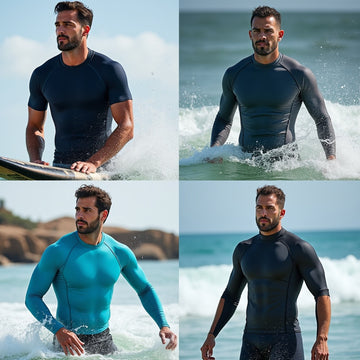Table of Contents
- Why Material Choice Matters in Rash Guards
- Common Rash Guard Fabrics Explained
- Polyester Rash Guards: Pros and Cons
- Nylon Rash Guards: Pros and Cons
- Spandex and Elastane: Flexibility vs Durability
- Fabric Blends: Balancing Performance and Comfort
- Environmental Impact of Rash Guard Materials
- Maintenance and Care Tips for Different Materials
- How to Choose the Right Material for Your Activity
Why Material Choice Matters in Rash Guards
Here’s the thing: not all rash guards feel or perform the same. Some fabrics wick moisture at warp speed, others resist abrasion like leather, and a few simply fall short on UV protection. When you’re paddling out, grappling on the mat, or just lounging poolside, one wrong pick can mean chafing, overheating, or fading prints.
Material choice also affects fit and stretch recovery—key if you’re bending into yoga poses or wrestling under hot gym lights. And let’s not forget odor resistance; certain synthetics fend off bacteria and stink, while others hold on to that “wet sock” aroma for days.
In short, your rash guard’s fabric is the engine behind its comfort, performance, and lifespan. Skimp here, and even the coolest design won’t save you from disappointment.
Common Rash Guard Fabrics Explained
Most men’s rash guards are built from a handful of synthetic fibers. Understanding each one helps you match material to mission:
- Polyester – strong, UV stable, quick-drying.
- Nylon – silky, stretchy, snag-resistant.
- Spandex/Elastane – offers the stretch that hugs your body.
- Blends – mix fibers for balanced traits; see our fabric blends guide.
Polyester Rash Guards: Pros and Cons
Polyester is the workhorse of rash guard materials. It’s tough, resistant to chlorine and saltwater, and holds dye well—so those bold graphics stay vibrant. But it may feel less soft against wet skin compared to nylon blends.
Many brands label their polyester as “micro” or “double knit” for added durability; these tighter weaves cut wind chill and help the material hold up under friction. If you’re hitting the waves hard or training in a hot pool, polyester often tops the list.
Pros
- High UV protection (UPF 50+).
- Excellent chlorine and saltwater resistance.
- Fast moisture-wicking and drying.
- Colorfast—prints stay crisp.
Cons
- Can feel coarse against bare skin.
- Limited stretch without blended spandex.
- Tendency to trap odors if not treated.
Nylon Rash Guards: Pros and Cons
Nylon brings a silkier hand feel and superior stretch compared to pure polyester. It drapes nicely and hugs muscle contours, making it a favorite for surfers and speed swimmers who crave that second-skin fit.
However, nylon may yellow under prolonged sun exposure, and its natural wicking isn’t as aggressive unless treated with special finishes. Expect a bit more care in the laundry—gentle cycles and air drying preserve the fiber’s smooth surface.
Spandex and Elastane: Flexibility vs Durability
Spandex (a brand name of elastane) is the spring in your rash guard’s step—up to 500% stretch without distortion. That flexibility is crucial for paddling and grappling, where unrestricted movement means the difference between flow and frustration.
On its own, spandex lacks the structural strength to resist abrasion. It’s woven into polyester or nylon to boost elasticity. The sweet spot is typically 10–20% spandex—enough give without sacrificing wear life.
Fabric Blends: Balancing Performance and Comfort
Blend ratios vary by use case. Surfers often prefer 85% polyester and 15% spandex—enough stretch, with quick-dry and UV focus. Swimmers eye 80/20 nylon-spandex for glide and shape retention.
Mixed fabrics can also incorporate recycled fibers or plant-based yarns for eco-minded softness. If you want to dig deeper, check our environmental impact insights.
Comparison Table: Key Fabric Characteristics
| Material | Durability | Stretch | Dry Rate | UV Protection | Eco Options |
|---|---|---|---|---|---|
| Polyester | High | Low–Medium | Fast | UPF 50+ | Recycled available |
| Nylon | Medium–High | High | Medium | UPF 30–50 | Limited |
| Spandex | Low | Very High | Slow | None alone | None |
| Poly/Spandex Blend | High | High | Fast | UPF 50+ | Recycled blends |
Environmental Impact of Rash Guard Materials
Eco awareness is shifting how fabrics are sourced. Recycled polyester (rPET) turns plastic bottles into high-performance yarn, cutting landfill waste and energy use. Some brands even dye at low temperatures to reduce water consumption and chemical runoff.
Nylon alternatives from castor beans or recycled fishing nets are emerging, though they still carry a higher cost. Spandex recycling remains challenging, but research is underway to reclaim elastane fibers post-wear.
Look for certifications like GRS (Global Recycled Standard) or OEKO-TEX, which vet both fiber origin and chemical safety. Conscious sourcing not only feels good but often signals better craftsmanship and traceability.
Maintenance and Care Tips for Different Materials
Proper care extends a rash guard’s lifespan and keeps colors vivid. Here’s a quick routine:
- Avoid heat. High temperatures break down elasticity and can yellow nylon—always wash in cool water.
- Use gentle detergent. Harsh soaps strip moisture-wicking finishes; mild formulas preserve performance coatings.
- Skip the dryer. Hang or lay flat in shade—direct sun can fade prints and weaken fibers.
- Rotate guards. Giving each piece time to air out prevents odor buildup and fabric fatigue.
For more on garment care, visit our care tips page.
How to Choose the Right Material for Your Activity
Your ideal fabric hinges on what you love to do:
- Surfing/Watersports: Prioritize polyester blends for UV defense and quick-dry comfort.
- Swimming/Speed Training: Lean into nylon-spandex for low drag and snug fit.
- BJJ/Grappling: Seek high-stretch nylon with reinforced panels for mat abrasion.
- Yoga/Paddleboard: Soft, breathable blends—bonus if they have anti-odor finishes.
Beyond activity, factor in climate: hot, humid conditions call for maximum breathability; cooler waters benefit from tighter weaves that block wind chill. Fit matters too—some fabrics run snug when dry and stretch out slightly when wet.
Ultimately, testing a few materials is the fastest route to your perfect match. But this guide should give you a solid starting point. Choose wisely, and your rash guard will feel like a second skin—supporting every stroke and every roll.
Updated: 08-18-2025










